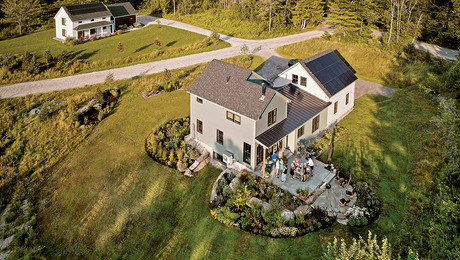I am in the process of installing a post-to-post handrail system from Coffman Stairs (the style is Hampton with an acorn newel post). The height of the handrail is 38 inches. What should the height be for the newel post?
Discussion Forum
Discussion Forum
Up Next
Video Shorts
Featured Story

By considering things like energy-efficient mechanicals, window orientation, and renewable energy sources, homes can be evaluated to meet the energy codes. Here's what the IRC has to say.
Highlights
"I have learned so much thanks to the searchable articles on the FHB website. I can confidently say that I expect to be a life-long subscriber." - M.K.

















Replies
Doesn't your Coffman dealer have a planning guide?
Height and ordered length ar two different things, depending on the location of the newel it can vary by another eight inches. A straight stairs with base newel - I'm guessing 54"
The top newel - 38-42"" but then it depends on the reveal and mounting method
Welcome to the
Taunton University of Knowledge FHB Campus at Breaktime.
where ...
Excellence is its own reward!
Thanks for the reply! I bought the stair guide from Coffman but it does not give any dimensions of any kind except for stair info (there is a rise/ run table). Last year I had to replace my deck railing and found out the railing height should be 36 to 38 inches and this also applies to interior railing heights (no info on the newel post height). I also bought Taunton's "Building Stairs" and several other books from Ortho, Black and Decker, etc. (anything on decks and stairs & railings)... no info on newel post height. I bought 6 foot newels because I plan on notching the newels (I have access to the joists from the basement's drop ceiling). I figured there is probably a general rule of thumb for a distance between the top of the handrail and the bottom of the acorn adornment.
About an inch and a half. Best thing to do is make a scale drawing in elevation. It's cheaper to make your mistakes on paper than in the field.Sometimes less embarrassing too.
Welcome to the Taunton University of Knowledge FHB Campus at Breaktime. where ... Excellence is its own reward!
I just pulled out the Coffman book. Look at chapter two to help you out with newel heights. Sometimes I will layout the stairs to scale on the wall near the stairs - you could use an extra peice of drywall - It will help you to recognize mistakes/problems before you make them.
Hi Paul,
I perused Chapter 2 in the Coffman Stair Building Guide book again per your recommendation. What I did not pick up on (senior moment maybe?) was the 2-1/2" reveal height for the starting newel (page 14, fig. 2-48) could also be applied to the landing newel.
Thanks,
Dale
I have seen several instances where the newel posts were too high. They look real silly sticking way up with the acorn perched on top. I like Piffin's inch-and-a-half suggestion, but what I usually do is temp up the parts into position for a few days so I have a chance to decide if it looks right or not. So, if you can set up a sample without cutting anything, do that. You'll probably have a decision by the second day.
A sheet of 1/4" white hardboard 42" x 8' along the stair nosing will give you the exact rail height .With hardboard blocked in place, plumb at bottom and top and mark 38" rail heights. Draw a straight line between theses 2 points which is your 38" rail height.
At exact newel location, plumb a line up and add the amount of reveal you want on the block above the rail height(1-1-1/2" )and you have the height to top of block...works every time.
Meets my parameters...fast quick and dead nuts.I often use it to verify Coffman's guidelines, especially if the newel moves in or out from their guidelines and changes the height.
Best regards,
silver
Dale,
Having installed about one bazzilion Stair Rails I Used to strive for some continuity. If you attach a 2 1/4 or 2 1/2" Handrail to the typical 5" bock Newel Post you usually end up with about 1 1/4" above and below.
Using this I then use 1 1/2" as my standard. I attach the rail to the post at 1 1/2" down from the top of the block portion of the post. I seldom have the need to deviate from that.
If you need a quick and easy way to figure out the height of your starting and landing newels let me know. It can be pretty simple.